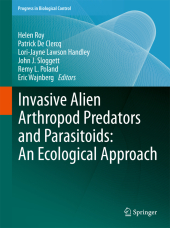 Neuerscheinungen 2013Stand: 2020-01-07 |
Schnellsuche
ISBN/Stichwort/Autor
|
Herderstraße 10
10625 Berlin
Tel.: 030 315 714 16
Fax 030 315 714 14
info@buchspektrum.de |

Patrick De Clercq, Lori-Jayne Lawson Handley, Lori-Jayne Lawson Handley, Remy L. Poland, Helen Roy, John J. Sloggett, Eric Wajnberg
(Beteiligte)
Invasive Alien Arthropod Predators and Parasitoids: An Ecological Approach
Herausgegeben von Roy, Helen; De Clercq, Patrick; Lawson Handley, Lori-Jayne; Sloggett, John J.; Poland, Remy L.
2012. 2013. viii, 324 S. 10 Tabellen, 10 Farbtabellen. 279 mm
Verlag/Jahr: SPRINGER NETHERLANDS; SPRINGER, BERLIN 2013
ISBN: 9400738293 (9400738293)
Neue ISBN: 978-9400738294 (9789400738294)
Preis und Lieferzeit: Bitte klicken
Here is a comprehensive overview of invasive alien arthropod predators and parasitoids, from key topics on invasive alien species to taxon-specific chapters. Covers invasion biology, and considers the benefits and risks of exotic biological control agents.
Understanding invasion biology, and the dynamics of biological control practices, requires a multidisciplinary approach, embracing and integrating all the research tools at our disposal, particularly modern molecular and modelling techniques. This book provides a comprehensive and current overview of invasive alien arthropod predators and parasitoids through 20 chapters, contributed by 69 internationally renowned scientists (previously published as peer-reviewed papers in BioControl - August 2011), ranging from broad reviews of key topics on invasive alien species (IAS) to taxon-specific chapters. The context of invasion biology is given through nine chapters focusing on current themes but highlighting future directions and knowledge gaps. Concepts are explored in detail through ten chapters focusing on a taxonomically diverse range of arthropods. The concluding chapter presents an objective approach to considering the benefits and risks of exotic biological control agents.
Foreword: Alien arthropod predators and parasitoids: an ecological approach.- 1. A conceptual framework for understanding arthropod predator and parasitoid invasions.- 2. Alien arthropod predators and parasitoids: interactions with the environment.- 3. Ecological genetics of invasive alien species.- 4. Detecting arthropod intraguild predation in the field.- 5. A ´Goldilocks´ hypothesis for dispersal of biological control agents.- 6. Can the enemy release hypothesis explain the success of invasive alien predators and parasitoids?.- 7. Ecological effects of invasive alien species on native communities, with particular emphasis on the interactions between aphids and ladybirds.- 8. Inventory of terrestrial alien arthropod predators and parasites established in Europe.- 9. Ecological effects and management of invasive alien Vespidae.- 10. Torymus sinensis : a viable management option for the biological control of Dryocosmus kuriphilus in Europe?.- 11. Ecology of Arachnida alien to Europe.- 12. The hitchhiker´s guide to alien ant invasions.- 13. Invasive alien Crustacea: dispersal, establishment, impact and control.- 14. Invasions by ladybugs, ladybirds, and other predatory beetles.- 15. Ecology of Harmonia axyridis in natural habitats within its native range.- 16. The global spread of Harmonia axyridis (Coleoptera: Coccinellidae): distribution, dispersal and routes of invasion.- 17. The chemical ecology of Harmonia axyridis .- 18. Living with the enemy: parasites and pathogens of the ladybird Harmonia axyridis .- 19. Benefi ts and risks of exotic biological control agents.
From the reviews:
"This hardcover volume comprises a foreword plus 19 review articles on the ecology of alien arthropod predators and parasitoids. ... This book covers its topic in a broad and multifaceted way and some chapters have the potential to become baseline reviews of their respective area. ... Overall, the book can be well recommended and appears particularly suited for scientists from related areas to gain a timely overview of the subject." (Martin H. Entling, Basic and Applied Ecology, Vol. 13 (8), December, 2012)


